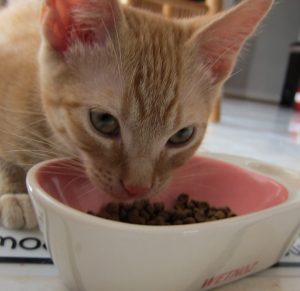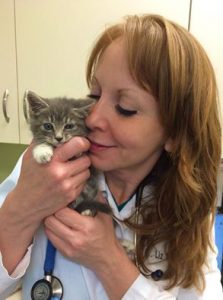 Dealing with a diabetic cat certainly brings about more owner responsibility. When hearing of your cat’s diagnosis, one may feel disheartened or worried about the cat’s wellbeing and health. While diabetes is something that must be treated daily, there are ways to make things easier. Here we will offer tips for dealing with diabetes in cats to help owners with this diagnosis.
Dealing with a diabetic cat certainly brings about more owner responsibility. When hearing of your cat’s diagnosis, one may feel disheartened or worried about the cat’s wellbeing and health. While diabetes is something that must be treated daily, there are ways to make things easier. Here we will offer tips for dealing with diabetes in cats to help owners with this diagnosis.
Food
The first thing you will want to do upon discovering the diagnosis is to change up their diet. A diabetic cat should never eat dry food, rather find a wet food low in carbohydrates. There are also canned wet foods made specifically for diabetic cats, but either will work. Furthermore, this food doesn’t have to be expensive, wet food good for diabetic cats come at all price-points to match you and your cat’s needs.

Another point to consider is that many diabetic cats also have renal disease, as a result, avoid high fiber foods.
By eating the right food, the better the blood glucose control and the better the chances are for remission.
Schedule Eating
To avoid dangerous health risks such as hypoglycemia, ensure that your cat’s feeding schedule is in line with their insulin intake.
Supplements
In addition to insulin therapy, your cat may do well with some additional supplements, speak with a vet or find a holistic vet who may be more knowledgeable about good supplements for diabetes.
Some supplements are known to aid with glucose metabolism and better control the blood sugar which can potentially reduce the need for insulin. These include cinnamon, L-carnitine, carnosine, green tea extract, fenugreek seed, and banana leaf. Ubiquinol, chromium, essential fatty acids, vitamin E, C and B, and bilberry are also known to be helpful.
Many cats with diabetes also suffer from urinary tract infections, a cranberry supplement can help prevent such infections.
Before stocking up on supplements please consult with a vet and maintain consistent communication. Be sure to continue with their prescribed insulin dosage, these supplements are not a replacement for insulin but a helpful addition. If it appears that insulin needs to be lowered, speak with the vet who will best adjust the dosage.
 Brush Their Teeth
Brush Their Teeth
Any sort of dental disease will make regulating diabetes much harder and can slow down the chance towards remission.
Activity
Diabetic or not, your cat should regularly be getting exercise. Physical activity helps to regulate the blood sugar, keep down fat, and overall provide a healthier lifestyle. Inactivity, on the other hand, can cause spikes in the blood sugar which builds an insulin resistance.
When a cat is diabetic, a major goal in treatment is to keep the blood sugar levels regular, getting your cat running, jumping, or even swatting at a toy for 10-15 minutes a day will make a huge difference and is a time for both pet and owner to bond and experience joy together. Seeing your cat playing, excited, and full of energy, even with a diagnosis can also fuel you with hope.

Monitor Their Habits – Know The Signs
Once everything has been regulated, know that proper management can reduce or even eliminate symptoms of diabetes. Get a sense of how often and how much water they drink, how much food they eat, and how often they use the litter box. Knowing what the new normal for your diabetic kitty is can be lifesaving, if they are suddenly drinking more and excessively thirsty, or using the litter box far more, you will have a better idea that something is off. In these cases, contact your veterinarian immediately.
Excessive Thirst
Cats with diabetes are likely to be more thirsty than they used to be or other household kitties. This may have been the telltale sign that tipped you off that something was off. Excessive thirst can lead to, or be a sign of dehydration which must be addressed immediately. It can also be a sign that something is wrong. In general, keep an eye on your cat’s drinking habits to know when something is wrong.
Keep on Eye on The Litter Box
With extra glucose in the blood, excess glucose will be eliminated with the urine in diabetic cats. This can cause an infection as bacteria love to feed off of sugar. As long as your cat is regularly using the litter box, things should be fine, but be on the lookout for irregular activity in the litter box, look for signs of frequent urination, going outside of the box, anything that is not normal. Speak with a vet immediately if you notice any of these symptoms as they may the signs of an infection which can quickly become dangerous.
Insulin
Be an Insulin Expert
One of the scariest parts about a diabetes diagnosis could be the fact that you will have to give your cat insulin. Needles, yikes! This is normal, many a pet parent come into the diagnosis with fear surrounding insulin injections, but it doesn’t have to be scary or hard. Your veterinarian will go over everything you need to know including how best to store and handle it, what type of syringes to use (insulin syringes), and teach you how to best inject your cat.
Insulin Doesn’t Have to be Hard
Once you have gotten over the initial fear of insulin and gotten used to it, it becomes easy, even remembering to do it twice a day becomes a habit. Things get easier for your kitty too, some cats may try and jump away, scratch, or even bite, but with your persistence and comfort, they too can get used to it. If your cat is truly being unruly, ask for some help from someone in the house to hold them down, put them in a towel so they have trouble fighting back, or even consider purchasing a cat restraint/grooming bag.
Insulin Can be a Pleasant Experience
Make this routine a pleasant one. Does your cat absolutely love to eat? If so, inject them towards the end of their meal and they’ll be too distracted to fight. Insulin given when they have food in their stomach is also good as it helps keep levels even and can even prevent overdose. Do they love a good brushing? Pull out the brush and as they relax into it, give them insulin, and continue their grooming as a reward. No matter what it is that your cat enjoys, try and incorporate that into their insulin routine to make for a more pleasant, even enjoyable experience.
Home Tests
Purchase a glucometer to regularly test your cat levels, record it on a spreadsheet that you can easily share with your veterinarian. This test ensures your cat is on the right track and can help catch things early on. The test is easy, just prick the cat’s ear or a paw. Your vet can show you the best way to do the test as well.
Know the Signs of Hypoglycemia
Hypoglycemia or low blood sugar is a dangerous diabetic emergency. To treat it as soon as possible, you will want to know the causes to avoid it and the signs to look out for. Hypoglycemia can occur if they receive too much insulin – this can be caused by over administering it if they did not eat or eat enough, vomited after eating, if their food portion has changed, or if their insulin dosage needs to be changed. Look out for signs of lethargy, behavioral changes, weakness, muscle twitching, seizures, coma, or even death.
If this occurs, administer the recommended treatment by your vet, if there is none, put a small amount of corn syrup into your cat’s gums and rub it in, after 1-2 minutes they should be responsive; try and get them to eat and call your vet immediately, they may need to be taken in for hospitalization.
Aside from looking out for signs of hypoglycemia look out for other signs of a medical emergency, such as vomiting or diarrhea, a decrease or loss of appetite, trouble urinating or blood in urine – a potential sign that there is a urinary tract infection.
 Other Medical Issues
Other Medical Issues
At times, diabetes can be cause be other underlying medical issues. Monitor the signs and symptoms your cat displays and speak with a vet to make sure there is nothing else going on.
Expenses
Unfortunately, treating a diabetic cat will be an ongoing expense. In general, it is highly recommended to create an emergency savings fund for your pets when they are young, so if anything comes up along the way, you won’t be financially held back or worse, unable to pay for the care your cat needs. Even saving a small amount per week or per month will add up and help.
If your cat already is diagnosed with diabetes, look a look at your finances and budget these expenses in, and find ways to save for upcoming costs.
To get an idea of what expenses will be, know that you will definitely need syringes, test strips and batteries for your glucometer, insulin, and other costs such as vet bills, or pet sitter bills. If you are even away for the night, a diabetic cat will still need attention, they will need to continue with routines such as scheduled feedings, and insulin injections.
Find an Online Support Group
A diabetes diagnosis in your cat can be scary, as much as your vet tries to soothe you, sometimes you just need a community, another cat mom or dad who is experiencing exactly what you are. A community where people offer tips and tricks that your vet may not have even known or mentioned. A place to seek comfort and to educate yourself.






